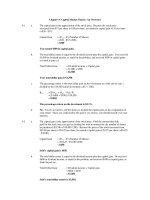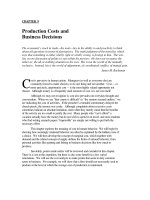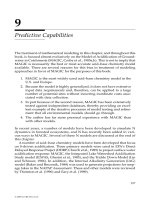Chapter 9 logistics management
Bạn đang xem bản rút gọn của tài liệu. Xem và tải ngay bản đầy đủ của tài liệu tại đây (335.13 KB, 30 trang )
Chapter 9
LOGISTICS
MANAGEMENT
LEARNING OBJECTIVES
You should be able to:
Understand the impact of transportation on company
and SCM
Identify the various modes of transportation
Understand the impact of warehousing on company
and SCM
Understand the key issues of international
transportation
Examine the interrelatedness of transportation,
warehousing, & material handling
MBA Nguyen Phi Hoang@2015_SCM
2
LEARNING OBJECTIVES
(Continued)
Identify a number of third-party logistics service providers
Summarize the important aspects of transportation
regulation and deregulation
Describe the various reverse logistics activities
Discuss some of the e-commerce issues in logistics
management
MBA Nguyen Phi Hoang@2015_SCM
3
CHAPTER OUTLINE
•
•
•
•
•
•
•
•
Introduction
The Fundamentals of Transportation
Warehousing and Distribution
The Impacts of Logistics on Supply Chain Management
Environmental Sustainability in Logistics
Logistics Management Software Applications
Global Logistics
Reverse Logistics
MBA Nguyen Phi Hoang@2015_SCM
4
Introduction
Logistics is necessary to:
Move goods from suppliers to buyers
Move finished goods to the customer
Products have little value to the customer until they
are moved to the customer’s point of consumption
Time utility- products are delivered at the right
time.
Place utility- products are delivered to the
desired location.
MBA Nguyen Phi Hoang@2015_SCM
5
Introduction
(Continued)
Logistics is:
“…that part of supply chain management
that plans, implements, and controls the
efficient, effective flow and storage of goods,
services, and related information from point
of origin to point of consumption in order to
meet customer requirements.”
Council of Supply Chain Management
Professionals
MBA Nguyen Phi Hoang@2015_SCM
6
Importance of
transportation
• Transportation cost account from 3% -6% of
annual budget of FMCGs
• Breakdown logistics cost:
•
•
•
•
•
Warehousing
Transportation
Inventory
Ordering
Administrative cost
MBA Nguyen Phi Hoang@2015_SCM
: 2,02%
: 3,34%
: 1,72%
: 0,43%
: 0,41%
7
In Viet Nam
Logistics cost of VN : Est. 20 - 25% GDP
Transportation cost of VN accounts from 4060% Logistics cost.
Transportation cost accounts around 20-25%
product cost which is produced in VN
MBA Nguyen Phi Hoang@2015_SCM
8
The Fundamentals of
Transportation
The Objective of Transportation
Minimize transportation cost to help reduce
product/service cost for firm
Deliver goods/services to correct address,
correct timing for clients
Satisfy customer needs
MBA Nguyen Phi Hoang@2015_SCM
9
The Fundamentals of
Transportation
(Continued)
Legal Forms of Transportation Transportation
service companies are classified legally as either
common, contract, exempt, or private carriers.
Common carriers- offer transportation services
to all shippers at published rates between
designated locations without discrimination.
Contract carriers- not bound to serve the general
public. Contract carriers serve specific
customers under contractual agreements.
MBA Nguyen Phi Hoang@2015_SCM
10
The Fundamentals of
Transportation
(Continued)
Legal Forms of Transportation
Exempt carriers - exempt from regulation of
services & rates & if they transport certain
exempt products like produce, livestock,
coal, or newspapers.
Private carrier - not subject to economic
regulation & typically transports goods for
the company owning the carrier.
MBA Nguyen Phi Hoang@2015_SCM
11
The Fundamentals of
Transportation
(Continued)
Modes of Transportation
Motor Carriers (trucks)- most flexible mode of
transportation & carries > 80% of U.S. freight.
Competes w/rail & air for short-to-medium hauls.
Less-than-truckload (LTL) & truck-load (TL) carriers
move small shipments & fees are higher
General freight carriers carry the majority of goods
shipped & include common carriers.
Specialized carriers transport liquid petroleum,
household goods, building materials, & other
specialized items.
MBA Nguyen Phi Hoang@2015_SCM
12
The Fundamentals of
Transportation
(Continued)
Modes of Transportation
Rail Carriers- compete when the distance is long & the
shipments are heavy or bulky.
Rail slow & inflexible, but have begun purchasing motor
carriers & can thus offer point-to-point pickup & delivery
service known as trailer-on-flatcar (TOFC) service.
Rail companies use each other’s rail cars. Keeping track
of rail cars & getting them where needed can be
problematic.
Railroad infrastructure & aging equipment are also
problems for the railroads.
MBA Nguyen Phi Hoang@2015_SCM
13
The Fundamentals of
Transportation
(Continued)
Modes of Transportation
Air Carriers - Expensive relative to other modes but
fast. Air carriers transport about 5 % of U.S. freight.
Airlines cannot carry extremely heavy or bulky cargo.
For light, high value goods over long distances quickly.
Most small cities & towns do not have airports.
Half of the goods transported by air are carried by
freight–only airlines, FedEx.
MBA Nguyen Phi Hoang@2015_SCM
14
The Fundamentals of
Transportation
(Continued)
Modes of Transportation
Water Carriers- Inexpensive, slow & inflexible.
Includes inland waterway, coastal & intercoastal, &
deep-sea.
Inland waterway transportation is used for heavy,
bulky, low-value materials (e.g., coal, grain).
Competes w/rail & pipeline.
Water carriers are paired w/trucks for door-to-door
delivery.
Supertankers are +1,500 ft long & 200 ft wide.
MBA Nguyen Phi Hoang@2015_SCM
15
The Fundamentals of
Transportation
(Continued)
Modes of Transportation
Pipeline Carriers - are limited in variety they can
carry.
Little maintenance once pipeline is running.
Materials hauled in a liquid or gaseous state.
MBA Nguyen Phi Hoang@2015_SCM
16
The Fundamentals of
Transportation
(Continued)
Modes of Transportation
Intermodal – the use of multiple modes of
transportation
Rail & motor carriers can offer point-to-point pickup &
delivery service known as trailer-on-flatcar (TOFC) service,
container-on-flatcar (COFC), or piggy-back service
Water & motor can offer point to point service for overseas
manufacturers
RO-ROs or roll-on-roll-off containerships truck trailers &
containers to be directly driven on & off the ship, without
the use of cranes
MBA Nguyen Phi Hoang@2015_SCM
17
The Fundamentals of
Transportation
(Continued)
Transportation Pricing
Cost of service pricing - varies based on fixed & variable
costs
Value of Service Pricing - services priced at market
bearing competitive levels
Terms of Sale - includes transportation FOB (free on
board) destination or dock
Pricing Negotiation - Since deregulation, negotiating
prices has become more common
Rate Categories - Classified as line haul rates, class rates,
exception rates, commodity rates, & miscellaneous rates
MBA Nguyen Phi Hoang@2015_SCM
18
Warehousing &
Distribution
Warehousing
Allows firms to store purchases, WIP( Work in process) &
finished goods and perform break bulk and assessment
services
Provides faster & more frequent deliveries & better
customer service
Crossdocking
To receive, breakdown, repackage, & distribute
components to a manufacturing location or finished
products to customers warehouse. This description more
accurately refers to a distribution center
MBA Nguyen Phi Hoang@2015_SCM
19
Warehousing &
Distribution
(Continued)
Importance & Types of Warehouses
Support purchasing, production, & distribution.
Consolidation warehouses collect LTL shipments for
transport in TL or CL quantities.
Private Warehouses
Owned by the firm storing goods.
Advantages:
• Reduces the cost, greater control, better workforce
utilization, & can generate income & tax advantages through
leasing of excess capacity &/or asset depreciation.
Disadvantages: Owning a private warehouse
represents a financial risk & loss of flexibility.
MBA Nguyen Phi Hoang@2015_SCM
20
Warehousing &
Distribution
(Continued)
Public Warehouses
Owned by for profit orgs & contracted out
• Breakbulk - shipments are broken down & items are
combined into specific customer orders.
• Repackaging
• Assembly
• Incoming & outgoing quality inspections.
• Material handling, equipment maintenance, &
documentation services
• Storage
• Advantages: Provides flexibility & investment cost savings
• Disadvantages : Lack of control.
MBA Nguyen Phi Hoang@2015_SCM
21
Warehousing &
Distribution
(Continued)
Warehouse Location
As the number of warehouses increases, the system
becomes more decentralized
Responsiveness & delivery service increase
because goods can be delivered faster .
However, warehousing operating & inventory costs also
increase. Trade-off between costs & customer service must
be considered
MBA Nguyen Phi Hoang@2015_SCM
22
Warehousing &
Distribution
(Continued)
Warehouse Location
Edgar Hoover recommended –
Market-positioned strategy - warehouses close to
customers to maximize distribution services &
improve transportation through economies of scale
Product positioned strategy - close to supply source
for firm to collect goods & consolidate
Intermediately positioned strategy - midway between
supply source & customers when distribution
requirements are high & product comes from various
locations
MBA Nguyen Phi Hoang@2015_SCM
23
Warehousing &
Distribution
(Continued)
Warehouse Location
Von Thunen – Optimum location of warehouse is
where the transportation cost is minimum. So Von
Thunen recommended that transportation costs should
be minimized when considering facility location. This
idea is similar with Weber”s location theory.
Greenhut”s theory - based on profit instead of
transportation costs. The optimum location is one that
maximizes profits, which may not be min. cost location
Other location theory will be discussed more in Chapter
11
MBA Nguyen Phi Hoang@2015_SCM
24
Warehousing &
Distribution
(Continued)
JIT warehousing (Lean Warehousing)
Emphasis on warehousing to support responsive
operations:
Emphasis on cross docking
Reduced lot sizes & shipping quantities
Commitment to customers & service quality
Increased automation
Increased assembly operations
MBA Nguyen Phi Hoang@2015_SCM
25









